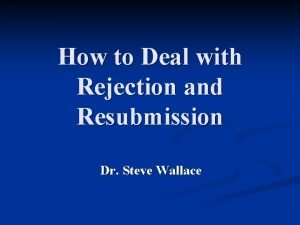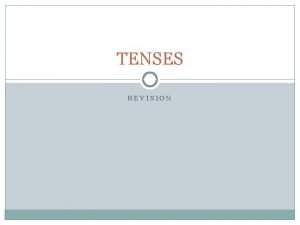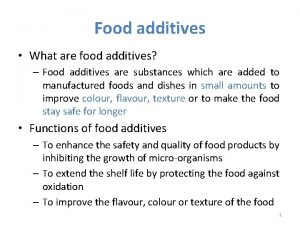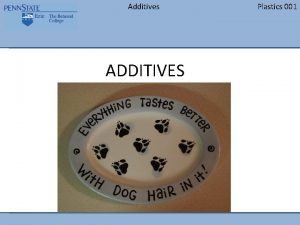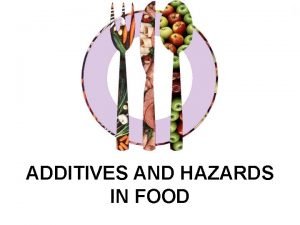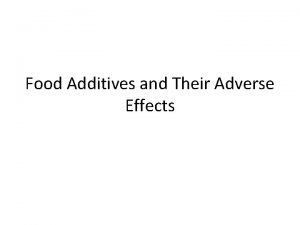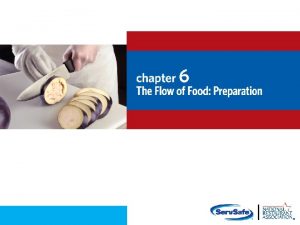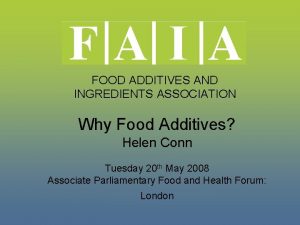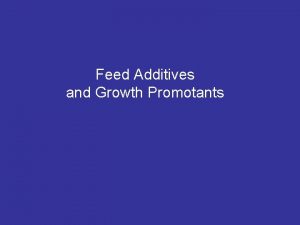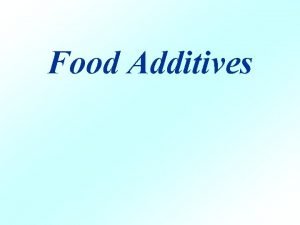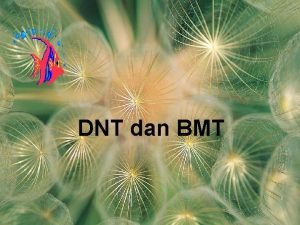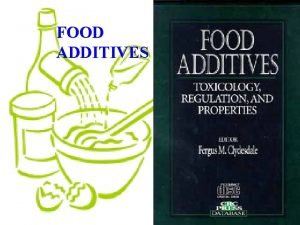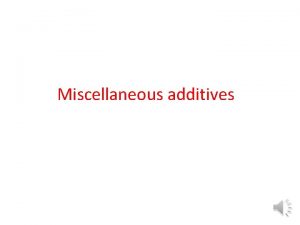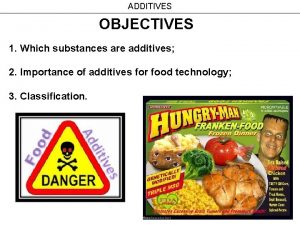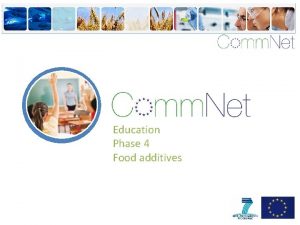Additives Revise and Test Additives q There are















- Slides: 15

Additives Revise and Test

Additives q There are over 300 listed additives and over 3500 flavourings. q 1. Give two reasons why there might be additives in these cream cakes. © ORCA Education Limited (2005) and suppliers, all rights reserved A Answers

Types of Additives. q 2. What are the following 3 types of additives? A Answers (a. ) N…. . I……. . (b. ) A……… (c. ) N…… are man-made copies of natural products such as vanillin or caramel. Also called synthesised. which are man-made but not found in nature e. g. saccharin (E 954) used as an alternative to sugar. found in a food but used for a specific purpose in another food e. g. beetroot juice (E 162) used for colouring ice cream. © ORCA Education Limited (2005) and suppliers, all rights reserved

Safety Issues q 3. What does the “E” prefix mean? q 4. What does the Government’s Food Advisory Committee do? q 5 What types of food do not declare what additives are in them? q 6. What health problems have been linked to additives? © ORCA Education Limited (2005) and suppliers, all rights reserved A Answers

Emulsifiers and Stabilisers q q q q This cream doughnut contains emulsifiers and stabilisers. 7. What are emulsifiers and stabilisers used for? 8. Which two of these statements say what emulsifiers and stabilisers do to the texture of food? (a. ) they improve it (b. ) they keep ingredients separate (c. ) they make it creamier (d. ) they make it coarse and sugary © ORCA Education Limited (2005) and suppliers, all rights reserved A Answers

Preservatives q q This Bramley Apple and Custard Doughnut has preservative E 203. 9. What do preservatives prevent the growth of: (a. ) sugar crystals, (b. ) fibre, or (c. ) micro organisms? 10. What are two advantages of adding preservatives to food to the retailer and consumer? 11. Name three commonly used preservatives. © ORCA Education Limited (2005) and suppliers, all rights reserved A Answers

Sweeteners q 12. Give one example of an artificial sweetener. q 13. Name two products they are commonly used in? q 14. Why is it difficult to use sweeteners in food that needs bulk e. g. cakes? q 15. What are two advantages of using artificial sweeteners? © ORCA Education Limited (2005) and suppliers, all rights reserved A Answers

Flavourings q 16. Why do we need to add flavourings to food? q 17. Give two examples of sources of natural flavourings. q 18. Monosodium glutamate is an artificial additive. What is its purpose? (a. ) to add colour (b. ) to bring out existing flavour (c. ) to add texture © ORCA Education Limited (2005) and suppliers, all rights reserved A Answers

Antioxidants q 19. Why are antioxidants added to food containing fat such as bacon and mayonnaise? q 20. What natural antioxidant would you add to sliced apple or pear to stop browning by enzymes? © ORCA Education Limited (2005) and suppliers, all rights reserved A Answers

Colours q 21. Give one reason why colours are added to food. q 22. Titanium dioxide is an example of an artificial or synthetic food colouring. Which root vegetable is a common natural source of pink or red colouring? © ORCA Education Limited (2005) and suppliers, all rights reserved A Answers

q Some Other Additives 23. Match the additive to its purpose. 1. Flour treatment agents 2. Humectants 3. Gelling agent 4. Modified starch a. Stops food from drying out b. Adds bulk and enables liquid to be incorporated easily c. Helps maintain product consistency d. Enhances texture © ORCA Education Limited (2005) and suppliers, all rights reserved A Answers

q q Consumer Choice Additives are thoroughly checked but there is pressure on the industry and government to reduce additives. Consumers can choose whether to buy products that contain additives. 24. Give two benefits of using additives. 25. Give one reason why some people avoid artificial additives. * © ORCA Education Limited (2005) and suppliers, all rights reserved Can I avoid food with additives? A Answers Do these additives add nutrients e. g. in my cereals? Does my porridge or fruit juice have additives? Are there artificial or natural colourings in my ketchup?

Suggested Answers q q q q Return 1. Preserve, emulsify, sweeten, colour, flavour, increase shelf life. 2. (a. ) Nature identical, (b. ) Artificial, (c. ) Natural. 3. The additive is acceptable as safe in the E. U. 4. Controls testing and approves new additives. 5. Unwrapped foods, alcoholic drinks, eating out, take-aways. 6. Asthma, hyperactivity, digestive complaints, eczema. 7. They prevent ingredients (water and oil) from separating. 8. (a. ) and (c. )They improve the texture making it creamier. 9. Help prevent the growth of micro-organisms that spoil food and can cause food poisoning. 10. Longer shelf life, bulk buying, cheaper products, more choice, less shopping trips. 11. Salt, vinegar, other acids, nitrates, sulphur dioxide. 12. Saccharin, aspartame. 13. Low calorie drinks, sweets, yogurt. 14. Sweeteners are 300 times sweeter and cannot replace sugar in similar amounts. 15. Low in calories and safer for teeth. * © ORCA Education Limited (2005) and suppliers, all rights reserved

Suggested Answers continued q q q q q Return 16. To add flavour for taste and restore the flavours lost in processing. 17. Spices, herbs, fruit, berries, oils. 18. (b. ) To bring out the existing flavour of an ingredient. 19. To prevent rancidity caused by oxidation. 20. Ascorbic acid (vitamin C) e. g. in lemon juice. 21. Restore colour after processing, make foods more attractive looking, give an expected colour. 22. Beetroot. 23. 1. c. , 2. a. , 3. d. , 4. b. 24. As a preservative, for added nutrients, for flavour, to enable more products to be available in the shops and throughout the year. 25. May cause allergic reaction, or be unsure about the long term effect. * © ORCA Education Limited (2005) and suppliers, all rights reserved

End Show Acknowledgements All images used in these presentations are the property of their owners, ORCA Education Limited and suppliers inc. Hemera Images, Jupiter Media Corp. and Animation Factory All rights are reserved. The Licence agreement applies to all elements of these presentations. ORCA. VT is a trademark of ORCA Education Limited © ORCA Education Limited (2005) and suppliers, all rights reserved
 Insidan region jh
Insidan region jh Decision letter sample
Decision letter sample Revise and resubmit letter example
Revise and resubmit letter example Evaluate and revise in assure model
Evaluate and revise in assure model How to revise and remember
How to revise and remember Retain reject revise
Retain reject revise Youre goals
Youre goals Judith murciano
Judith murciano Revise and editing
Revise and editing Natural and artificial food additives
Natural and artificial food additives Food technology revision
Food technology revision Revision present simple and continuous
Revision present simple and continuous Remember simple past
Remember simple past How to revise for english literature
How to revise for english literature Paper 1 literature aqa
Paper 1 literature aqa Kuesioner tidak terstruktur
Kuesioner tidak terstruktur


